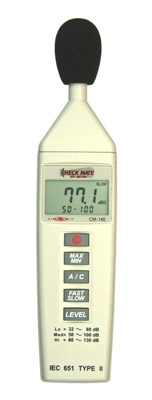The Check Mate SPL Meter: For Good Measure

What's the most popular audio evaluation tool in the world? It's RadioShack's model 33-4050 sound level meter. What's the most controversial audio evaluation tool in the world? That same little $45 meter. It's controversial because it's a compromise: It's got idiosyncrasies, but there's never been an affordable alternative.
Until now.
 |
First, some background. The RadioShack meter's been available for at least as long as I've been shopping at RadioShack - and when I started shopping there, they still sold 8-track players. I've seen it in the hands of everyone from casual home theater enthusiasts to the world's top audio scientists. The design has changed cosmetically from the original, but it's basically the same as it's always been.
But the 33-4050 was designed for rough measurements of broadband audio - i.e., music and environmental noise. It was never intended for evaluation of room acoustics, but that's how many people use it. They play tones at various audio frequencies, then adjust equalizers or acoustic treatment products so the needle on the meter reads roughly the same at all frequencies.
That might be a great idea were the 33-4050 a professional-grade instrument, but it's not. In fact, some websites offer charts that help you compensate for the errors. Some companies have created CDs with test tones adjusted to compensate for the meter's inaccuracy. And some people have even published circuit mods that correct the response of some older versions of the meter.
A few weeks ago, I was using one of my four or five RadioShack meters to do some quick'n'dirty subwoofer measurements when it dawned on me: It's a big world. There's got to be something better out there!
What I needed was something pretty good that costs no more than $200, which would rank it as a fun impulse buy for me and most other audio enthusiasts. Only one of the countless meters I found seemed to fit the bill: the Galaxy Audio Check Mate CM-140; list price: $149.99 (best price I found: $99.99 at Musician's Friend). Sold!
The CM-140's feature list nearly mirrors the 33-4050's. Both include fast or slow response, C-weighting (which filters out sounds below 32 Hz and above 8 kHz), and A-weighting (which is roughly similar to C-weighting but filters out sounds below about 500 Hz). And both get their juice from a 9-volt battery and have a microphone output jack and recessed screw adjustment for calibration.
The biggest difference is that the CM-140 is digital, a feature with pros and cons. The needle on the 33-4050's analog meter tends to sit nice and steady. In contrast, digital meters are more precise but often harder to read because the numbers usually don't hold steady (RadioShack also offers a digital meter.) The CM-140 has maximum and minimum hold, which makes it easy to measure the loudest sound pressure level your system can achieve, or the quietest ambient level your room can reach. And the CM-140 offers a wider measurement range: 32 to 130 dB, versus about 54 to 126 dB for the 33-4050.
Unlike the 'Shack meter, the CM-140 conforms to an international performance standard, specifically IEC 60651 Type 2, which was established in 1979 and is now rather outdated - but hey, any standard is better than none, right? The latest standard is 61672, established in 2003, which specifies greater accuracy and includes a useful Z-weighting option, which makes the meter's response dead even from 10 Hz to 20 kHz. Sadly, the cheapest 61672-compliant meter I could find cost more than $2,000. But that's for OSHA inspectors and fancy engineering labs. Audio geeks probably don't need such precision.
Besides being undeniably cooler and more impressive (at least to audio geeks), does the CM-140 offer any other real advantages over the 'Shack's standard-bearer? According to my other lab gear, yeah.
- Log in or register to post comments

























































